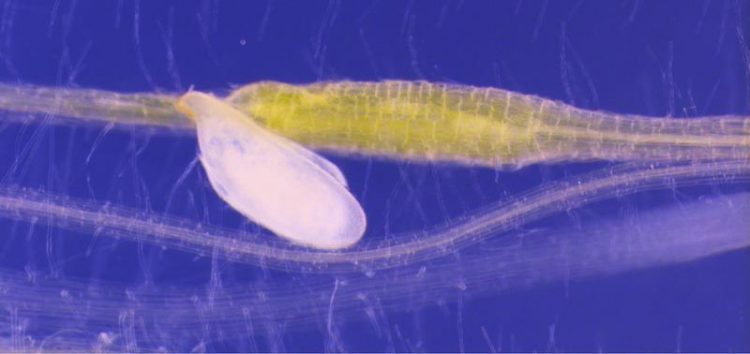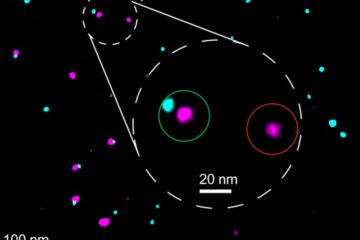Plant pest reprogramme the roots

The beet cyst nematode (Heterodera schachtii) sucks at a plant root. The pest reprogrammes the root with a plant hormone. (c) Photo: Zoran Radakovic
The beet cyst nematode (Heterodera schachtii) is a pipsqueak of less than a millimetre in length, but it causes huge yield losses in sugar beet. Not only are infected beets smaller than normal, but also they have an increasing number of lateral roots and experience a drastic decrease in sugar yield.
This makes the pest a talking point as a cause of the dreaded “beet fatigue”, especially in traditional sugar beet growing such as Bonn. To date, however, it was not clear how the nematodes stimulate the development of a nurse cell system inside the root, which they absolutely need as a food source.
It arises from the fact that cells divide increasingly, merge with each other and eventually swell. “For a long time it was speculated that plant hormones play a role in the formation of a nurse cell system in roots,” says Prof. Dr. Florian Grundler from the Molecular Phytomedicine, University of Bonn. Since the nematodes lose their ability to move after penetrating into the roots, they are particularly dependent on the development of tumorous nurse cell system.
Pest uses degradation products of its metabolism
Together with scientists from Columbia (USA), Olomouc (Czech Republic), Warsaw (Poland), Osaka (Japan) and the Freie Universitaet Berlin, the researchers at the University of Bonn have used Arabidopsis thaliana as a model plant to discover that the beet cyst nematode itself produces the plant hormone cytokinin.
“The nematode has been able to employ a breakdown product of its own metabolism as a plant hormone to control the development of plant cells,” said lead author and research group leader Dr Shahid Siddique. The pest programmed the plant roots in beets to form a special nutritive tissue, which the nematode uses for its own growth.
The research team initially did not know whether the pest uses the hormone plants produce or whether it produces and releases the hormone itself. The scientists blocked cytokinin production in the plant – the nematode nevertheless continued to grow because it was not dependent on the plant-produced hormone.
Only when the agricultural experts blocked a special receptor at the docks to override the worm-produced hormone did they starve the pest, discovering that the hormone is important for the formation of the nurse cell system. “In this case, Heterodera schachtii cannot use its ability to produce cytokinin anymore, because a vital pathway was interrupted in the root cells,” explained Dr Siddique.
New options for plant breeding
Although this discovery is a result of basic research, it opens up new avenues in plant breeding. “On the one hand the result is an important contribution to the fundamental understanding of parasitism in plants, and on the other hand it can help to reduce the problem of cyst nematode in important agricultural crops,” said Prof Grundler. Now that an important mechanism had been found by the research, we are looking for an appropriate strategy to use these results specifically in resistance breeding.
Publication: A parasitic nematode releases cytokinin that controls cell division and orchestrates feeding site formation in host plants, Proceedings of the National Academy of Sciences (PNAS), DOI: 10.1073/pnas.1503657112
Contact for the media:
Prof. Dr. Florian Grundler
Molekulare Phytomedizin
Universität Bonn
Tel. ++49-(0)228-731675
E-mail: grundler@uni-bonn.de
Media Contact
More Information:
http://www.uni-bonn.deAll latest news from the category: Life Sciences and Chemistry
Articles and reports from the Life Sciences and chemistry area deal with applied and basic research into modern biology, chemistry and human medicine.
Valuable information can be found on a range of life sciences fields including bacteriology, biochemistry, bionics, bioinformatics, biophysics, biotechnology, genetics, geobotany, human biology, marine biology, microbiology, molecular biology, cellular biology, zoology, bioinorganic chemistry, microchemistry and environmental chemistry.
Newest articles

High-energy-density aqueous battery based on halogen multi-electron transfer
Traditional non-aqueous lithium-ion batteries have a high energy density, but their safety is compromised due to the flammable organic electrolytes they utilize. Aqueous batteries use water as the solvent for…

First-ever combined heart pump and pig kidney transplant
…gives new hope to patient with terminal illness. Surgeons at NYU Langone Health performed the first-ever combined mechanical heart pump and gene-edited pig kidney transplant surgery in a 54-year-old woman…

Biophysics: Testing how well biomarkers work
LMU researchers have developed a method to determine how reliably target proteins can be labeled using super-resolution fluorescence microscopy. Modern microscopy techniques make it possible to examine the inner workings…





















